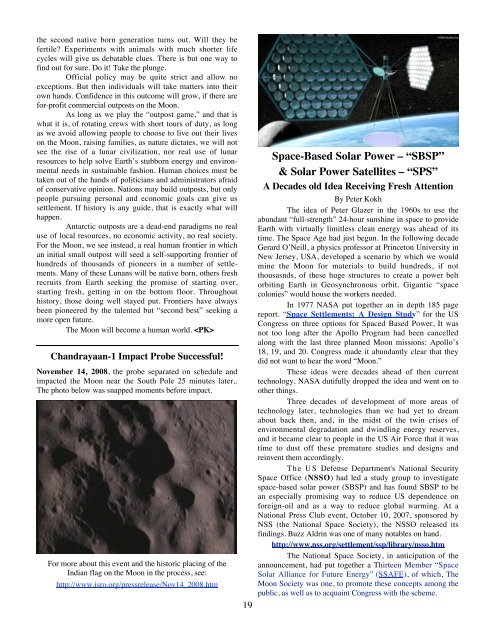Chandrayaan-1 Flies! Welcome to Moon Miners' Manifesto India ...
Chandrayaan-1 Flies! Welcome to Moon Miners' Manifesto India ...
Chandrayaan-1 Flies! Welcome to Moon Miners' Manifesto India ...
You also want an ePaper? Increase the reach of your titles
YUMPU automatically turns print PDFs into web optimized ePapers that Google loves.
the second native born generation turns out. Will they be<br />
fertile Experiments with animals with much shorter life<br />
cycles will give us debatable clues. There is but one way <strong>to</strong><br />
find out for sure. Do it! Take the plunge.<br />
Official policy may be quite strict and allow no<br />
exceptions. But then individuals will take matters in<strong>to</strong> their<br />
own hands. Confidence in this outcome will grow, if there are<br />
for-profit commercial outposts on the <strong>Moon</strong>.<br />
As long as we play the “outpost game,” and that is<br />
what it is, of rotating crews with short <strong>to</strong>urs of duty, as long<br />
as we avoid allowing people <strong>to</strong> choose <strong>to</strong> live out their lives<br />
on the <strong>Moon</strong>, raising families, as nature dictates, we will not<br />
see the rise of a lunar civilization, nor real use of lunar<br />
resources <strong>to</strong> help solve Earth’s stubborn energy and environmental<br />
needs in sustainable fashion. Human choices must be<br />
taken out of the hands of politicians and administra<strong>to</strong>rs afraid<br />
of conservative opinion. Nations may build outposts, but only<br />
people pursuing personal and economic goals can give us<br />
settlement. If his<strong>to</strong>ry is any guide, that is exactly what will<br />
happen.<br />
Antarctic outposts are a dead-end paradigms no real<br />
use of local resources, no economic activity, no real society.<br />
For the <strong>Moon</strong>, we see instead, a real human frontier in which<br />
an initial small outpost will seed a self-supporting frontier of<br />
hundreds of thousands of pioneers in a number of settlements.<br />
Many of these Lunans will be native born, others fresh<br />
recruits from Earth seeking the promise of starting over,<br />
starting fresh, getting in on the bot<strong>to</strong>m floor. Throughout<br />
his<strong>to</strong>ry, those doing well stayed put. Frontiers have always<br />
been pioneered by the talented but “second best” seeking a<br />
more open future.<br />
The <strong>Moon</strong> will become a human world. <br />
<strong>Chandrayaan</strong>-1 Impact Probe Successful!<br />
November 14, 2008, the probe separated on schedule and<br />
impacted the <strong>Moon</strong> near the South Pole 25 minutes later,.<br />
The pho<strong>to</strong> below was snapped moments before impact.<br />
For more about this event and the his<strong>to</strong>ric placing of the<br />
<strong>India</strong>n flag on the <strong>Moon</strong> in the process, see:<br />
http://www.isro.org/pressrelease/Nov14_2008.htm<br />
19<br />
Space-Based Solar Power – “SBSP”<br />
& Solar Power Satellites – “SPS”<br />
A Decades old Idea Receiving Fresh Attention<br />
By Peter Kokh<br />
The idea of Peter Glazer in the 1960s <strong>to</strong> use the<br />
abundant “full-strength” 24-hour sunshine in space <strong>to</strong> provide<br />
Earth with virtually limitless clean energy was ahead of its<br />
time. The Space Age had just begun. In the following decade<br />
Gerard O’Neill, a physics professor at Prince<strong>to</strong>n University in<br />
New Jersey, USA, developed a scenario by which we would<br />
mine the <strong>Moon</strong> for materials <strong>to</strong> build hundreds, if not<br />
thousasnds, of these huge structures <strong>to</strong> create a power belt<br />
orbiting Earth in Geosynchronous orbit. Gigantic “space<br />
colonies” would house the workers needed.<br />
In 1977 NASA put <strong>to</strong>gether an in depth 185 page<br />
report. “Space Settlements: A Design Study” for the US<br />
Congress on three options for Spaced Based Power, It was<br />
not <strong>to</strong>o long after the Apollo Program had been cancelled<br />
along with the last three planned <strong>Moon</strong> missions: Apollo’s<br />
18, 19, and 20. Congress made it abundantly clear that they<br />
did not want <strong>to</strong> hear the word “<strong>Moon</strong>.”<br />
These ideas were decades ahead of then current<br />
technology. NASA dutifully dropped the idea and went on <strong>to</strong><br />
other things.<br />
Three decades of development of more areas of<br />
technology later, technologies than we had yet <strong>to</strong> dream<br />
about back then, and, in the midst of the twin crises of<br />
environmental degradation and dwindling energy reserves,<br />
and it became clear <strong>to</strong> people in the US Air Force that it was<br />
time <strong>to</strong> dust off these premature studies and designs and<br />
reinvent them accordingly.<br />
The US Defense Department's National Security<br />
Space Office (NSSO) had led a study group <strong>to</strong> investigate<br />
space-based solar power (SBSP) and has found SBSP <strong>to</strong> be<br />
an especially promising way <strong>to</strong> reduce US dependence on<br />
foreign-oil and as a way <strong>to</strong> reduce global warming. At a<br />
National Press Club event, Oc<strong>to</strong>ber 10, 2007, sponsored by<br />
NSS (the National Space Society), the NSSO released its<br />
findings. Buzz Aldrin was one of many notables on hand.<br />
http://www.nss.org/settlement/ssp/library/nsso.htm<br />
The National Space Society, in anticipation of the<br />
announcement, had put <strong>to</strong>gether a Thirteen Member “Space<br />
Solar Alliance for Future Energy” (SSAFE), of which, The<br />
<strong>Moon</strong> Society was one, <strong>to</strong> promote these concepts among the<br />
public, as well as <strong>to</strong> acquaint Congress with the scheme.















